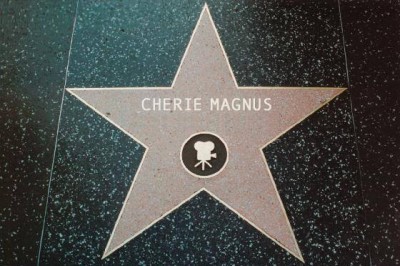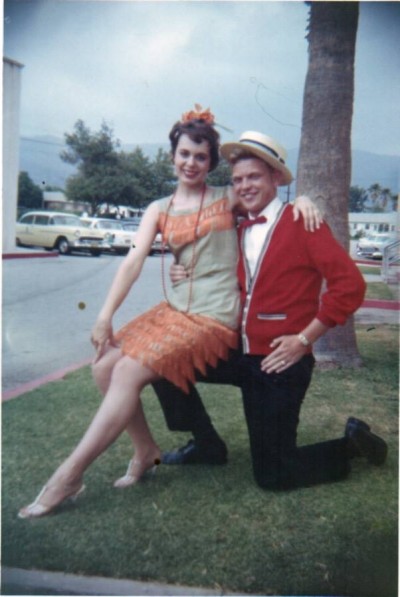From Trailer Park to Tango: When Cherie Magnus Danced on the Edge
“I will dance forever if possible. Dance has always been there for me throughout my life’s difficulties. It has sustained and saved me.” – Cherie Magnus
Cherie Magnus’ memoir, Arabesque: Dancing on the Edge in Los Angeles, begins with the author’s sixteenth birthday when her father gives her a 1957 Mercury Montclair convertible. It’s a great ride, shiny and black with a ragtop, but it’s also a gift of freedom. Her parents’ constant moving and their rocky personal relationship made the ground under Cherie’s feet as unstable as Los Angeles in an earthquake. Having wheels means she can get to her dance classes consistently, continue to attend the same high school, and eventually drive from the Valley to Westwood to attend UCLA.
Magnus previously wrote about her life as a tango dancer in her first memoir, The Church of Tango, but this is a prequel, covering her young adult years, mostly her life in college. She always knew she wanted to dance, from the very first group classes she took in ballet, tap and acrobatics at small local studios. Her passion was for ballet, for the forms and lines and beauty of the idiom. It took her far away from her reality: a father who could be drunk, a mother who was unreliable, and grandparents who could be exceptionally generous but only when things were done on their terms.
College should have been Cherie’s escape. She wanted to attend Texas Christian University which was the only college in the country that had a dance degree in ballet but her parents were adamant that she attend UCLA, which was local, well-respected and affordable, but its dance degree was in modern, an idiom that challenged and bored Magnus. It was during her freshman year that she met Paul, a grad student in engineering who was handsome and smart. She fell head over heels in love.
The beginning of the new decade – 1960 – heralded some profound social changes but for a young woman, much remained the same. Women were not at all “liberated” and Magnus found herself caught in the middle. She wanted desperately to be independent but Paul assumed she would do ashe wanted. He dictated how their love life progressed; he insisted she stop performing and pursue teaching instead. She wanted very much to please him, as women of her generation were expected to, but she’d spent years dancing and choreographing and training for a life of performance.
And this begins the “edge” of Cherie Magnus’ life: not only does the title of her memoir refer to her life in the Valley (which is geographically on LA’s “edge”) but also the time she spent hospitalized for depression. While the breakdown might have been triggered by a fellow student’s death, it had been building for a while. Her parents’ separation, Paul’s lack of commitment, a realization that she wasn’t pursuing her passion – all contributed to a profound feeling of despair and hopelessness. Magnus became incredibly lonely and worried constantly. Eventually she was hospitalized but like any dancer, she found her center again. Although ballet would not be her professional future, she would find her dance passion in tango.
After reading her memoir, there was so much more I wanted to know. Cherie Magnus very graciously agreed to an interview.
Leigh Purtill: In the opening chapters of your memoir, you describe the frequent moves your family made from rented house to rented house, town to town, but the one constant was dance. Can you expand a bit on how you were first exposed to dance?
Cherie Magnus: I remember clearly my first ballet class. It was in Pacific Palisades, a few blocks from where we were living at the time. I was three years old and I recall how enchanted I was with the French terms. It was an epiphany for me and I knew then I wanted ballet for the rest of my life.
LP: You note that before Balanchine women in ballet had real women’s bodies but he changed all that and you subsequently didn’t have the “typical” ballet dancer’s body. Did you have a healthy attitude toward food and your body growing up?
CM: I grew up in the 50s and the Balanchine Body concept hadn’t yet been written in stone. There was still some wiggle room. The photos of great ballerinas of the past in books and magazines showed “normally built” women, although very petite. I am tall, and pas de deux class was always fraught with anxiety—would there be a tall boy to dance with me? I was aware of my body type and while I would have liked to lose weight, I knew I could never be “delicate” looking. And that’s when I imagined a career in jazz and Broadway-style dance and as a choreographer.
“…the difficult choices we make as teenagers can send us on unexpected and surprising paths, but can still lead to happiness and fulfillment.” – Cherie Magnus
LP: I love that you started your own small dance school at the trailer park where you lived before college. Later you say you know you needed to dance first before you could settle into a career as a choreographer. Did your college boyfriend Paul and his mother (who wanted you to teach) eventually influence you?
CM: The Royale School of Ballet in the trailer park was a wonderful experience for me. But as always during my childhood, my parents were irresponsible and flaky and we soon moved to another town in the Valley so that was that. But I never wanted to be “just a teacher,” even of ballet. Besides I was under the impression that you had to make a name for yourself first as a dancer before anyone would hire you to teach or choreograph. Teaching ballet was what professional dancers did when they retired from performing.
LP: And speaking of Paul, you say he wanted you to give up dance yet that was an essential part of who you were. Do you think you grew stronger out of that relationship? Did it give you the courage to do what you really wanted?
CM: It’s hard to know looking back what I really wanted. It was a very confusing time. I do know that I would have given up everything, all my dreams, anything to marry Paul. That was the culture then. A girl’s goal in life was to find love and marriage, have children, and make a happy home. If she could also have a career, good on her—as long as her husband was happy. I don’t regret the relationship, even though it was tragic. And perhaps it did make me stronger, as all the clichés assure us difficult times will. But because it ended badly, I really needed my family or some place of emotional support, and I had none. Not my parents or my grandparents, not my best friend Carla, the girl I considered my sister, and certainly not my boyfriend. I think my life would have been different if at that moment I hadn’t felt totally alone and tossed to the winds.
The thing was, by the time Paul demanded I quit dance, I was already hooked on UCLA and a good university education. At that point I couldn’t have thrown that away to run to New York to dance. Getting my degree became my focus and my source of stability.
LP: You candidly discuss being hospitalized for depression as well as your desire to be a liberated woman yet feeling restrained by the “rules” women were meant to follow for their love lives and careers. Do you think the two were related?
CM: I think I was caught in a wrinkle in history, just when awareness was rising and changes were about to happen. It was a crucial time as a woman to be making important life decisions. Ten years later I would have been more confident at age eighteen, but in 1961 the future of women in our society wasn’t clear, just confusing. I felt caught in between the norms for women of the 50s and the women of the 60s that were diametrically opposed. But still, life-changing decisions had to be made. So along with the chaos in my own life, it was just too much. Those teenage years often include depression anyway, but most kids weather the storm—as I did in time.
LP: At the end of the memoir, you hint at what is to come in your life: tango. Without spoiling anything for readers who might want to check out your earlier memoir, The Church of Tango, can you briefly mention the shift from ballet to tango? Were you eager to step away from the rigors of ballet?
CM: I was never eager to leave ballet. I loved the rigors! It was the opposite of chaos and took me away from my problems, all but the fear that my physical makeup would preclude a ballet career….But I didn’t find the tango until many years later. When my husband died, the only thing that saved me at first was dancing every night at a country and western club in Santa Monica. Every night for a year…and then I found the tango and made my first trip to Buenos Aires and my life took on a new direction. I taught tango with my Argentine partner for nine years in Buenos Aires. I wrote about it in The Church of Tango—how dance was my salvation, carrying me through tragedy, loss, cancer, pain.
Leigh Purtill is a ballet instructor, choreographer and coach in Los Angeles where she lives with her husband and dog. She received her master’s degree in Film Production from Boston University and her bachelor’s in Anthropology and Dance from Mount Holyoke College. She has published two novels with Penguin’s Razorbill imprint. She currently teaches all levels of ballet to adults in LA. Zombie ballet is her passion. She can be reached through her blog: www.fitballet.blogspot.com.


Nice to read this! I just posted a review of the first book on my ballet blog!
ReplyDelete